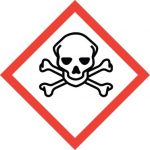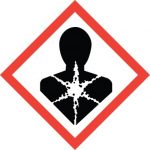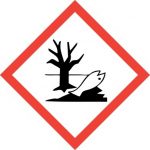1. PRODUCT AND COMPANY IDENTIFICATION
Product Name: Uranyl Acetate Di-Hydrate
Synonyms: Uranyl Acetate
Index-No.: 092-002-00-3
CAS RN: [6159-44-0]
Identified uses: Laboratory chemicals, manufacture of substances.
Supplier
IBI Labs
3495 N. Dixie Hwy. Unit # 8
Boca Raton, FL 33431
Tel: 561-826-0061 Fax: 561-892-8450
Emergency Telephone Numbers
INFOTRAC
USA & Canada contact number: 1-800-535-5053 – International contact number: 1-352-323-3500
2. HAZARDS IDENTIFICATION
Classification of The Substance or Mixture
GHS Classification in accordance with 29 CFR 1910 (OSHA HCS):
Acute toxicity, Oral (Category 2), H300
Acute toxicity, Inhalation (Category 2), H330
Specific target organ toxicity – repeated exposure (Category 2), H373
Acute aquatic toxicity (Category 2), H401
Chronic aquatic toxicity (Category 2), H411
For the full text of the H-Statements mentioned in this Section, see Section 16.
GHS Label Elements, Including Precautionary Statements
Pictogram
Signal word Danger.
Hazard statements:
H300 + H330 Fatal if swallowed or if inhaled.
H373 May cause damage to organs through prolonged or repeated exposure.
H411 Toxic to aquatic life with long lasting effects.
Precautionary statements:
P260 Do not breathe dust/fume/gas/mist/vapors/spray.
P264 Wash skin thoroughly after handling.
P270 Do not eat, drink, or smoke when using this product.
P271 Use only outdoors or in a well-ventilated area.
P273 Avoid release to the environment.
P284 Wear respiratory protection.
P301 + P310 IF SWALLOWED: Immediately call a POISON CENTER or doctor/physician.
P304 + P340 IF INHALED: Remove patient to fresh air and keep at rest in a position comfortable for breathing.
P310 Immediately call a POISON CENTER, or doctor/physician.
P320 Specific treatment is urgent (see supplemental first aid instructions on this label).
P330 Rinse mouth.
P391 Collect spillage.
P403 + P233 Store in a well-ventilated place. Keep container tightly closed.
P405 Store locked up.
P501 Dispose of contents/ container to an approved waste disposal plant.
Hazards not otherwise classified (HNOC) or not covered by GHS: Radioactive.
3. COMPOSITION AND INFORMATION ON INGREDIENTS, PHYSICAL AND CHEMICAL PROPERTIES
- Formula: UO2(CH3COO)2·2H2O
- Molecular Formula: C4H10O8U
- Appearance Form: Crystalline Color (yellow)
- Odor: Slight odor of acetic acid
- Density, g/cm³: 2.890 g/cm³
- Melting Point: Decomposes
- Decomposition temperature 275 °C (527 °F) –
- Molecular Weight: 424.15 g/mol
- CAS-No.: 6159-44-0
- EC-No.: 208-767-5
Component Classification Concentration
Bis(acetato-O)dioxouranium dihydrate
Acute Tox. 2; STOT RE 2;
Aquatic Acute 2; Aquatic
Chronic 2; H300 + H330, H373, H411
For the full text of the H-Statements mentioned in this Section, see section 16.
4. FIRST AID MEASURES
General advice:
- Consult a physician.
- Show this safety data sheet to the doctor in attendance.
- Move out of dangerous areas.
If inhaled:
- If breathed in, move the person into fresh air.
- If not breathing, give artificial respiration.
- Consult a physician.
In case of skin contact:
- Wash off with soap and plenty of water.
- Take the patient immediately to the hospital.
- Consult a physician.
In case of eye contact: Rinse thoroughly with plenty of water for at least 15 minutes and consult a physician.
If ingested:
- Never give anything by mouth to an unconscious person.
- Rinse mouth with water.
- Consult a physician.
Most important symptoms and effects, acute and delayed: The most important known symptoms and effects are described in the labeling (see sections 2 and 11).
Indication of any immediate medical attention and special treatment needed: No data available.
5. FIREFIGHTING MEASURES
Suitable extinguishing media: Use water spray, alcohol-resistant foam, dry chemicals, or carbon dioxide.
Special hazards arising from the substance or mixture: Carbon oxides, Uranium oxides.
Firefighting and Other Immediately Dangerous to Life or Health Conditions
Use any self-contained breathing apparatus with a full facepiece respirator and a high-efficiency particulate filter.
Use any supplied-air respirator with a full facepiece operated in a pressure-demand or other positive-pressure mode or other positive-pressure modes with an auxiliary self-contained breathing apparatus operated in pressure-demand or other positive-pressure modes.
6. ACCIDENTAL RELEASE MEASURES
Personal precautions, protective equipment, and emergency procedures:
- Wear respiratory protection.
- Avoid dust formation.
- Avoid breathing vapors, mist, or gas.
- Ensure adequate ventilation.
- Evacuate personnel to safe areas.
- Avoid breathing dust.
For personal protection see section 8.
Environmental precautions:
- Prevent further leakage or spillage if safe to do so.
- Do not let the product enter drains.
- Discharge into the environment must be avoided.
Methods and materials for containment and cleaning up:
- Pick up and arrange disposal without creating dust.
- Sweep up and shovel.
- Keep in suitable, closed containers for disposal.
Reference to other sections: For disposal see section 13.
7. HANDLING AND STORAGE
Precautions for safe handling:
- Avoid contact with skin and eyes.
- Avoid the formation of dust and aerosols.
- Provide appropriate exhaust ventilation at places where dust is formed.
For precautions see section 2.
Conditions for safe storage, including incompatibilities: Keep the container tightly closed in a dry and well-ventilated place.
Specific end uses: Apart from the uses mentioned in section 1 no other specific uses are stipulated.
8. EXPOSURE CONTROLS AND PERSONAL PROTECTION
Control Parameters
Components with workplace control parameters:
Component CAS-No. Value Control parameters.
Basis Bis(acetato-O)dioxouranium dihydrate.
6159-44-0 TWA 0.2 mg/m3 USA. ACGIH Threshold Limit Values (TLV).
Remarks Confirmed human carcinogen.
TWA 0.05 mg/m3 USA. Occupational Exposure Limits.
(OSHA) – Table Z-1 Limits for Air Contaminants.
TWA 0.05 ppm.
USA. OSHA – TABLE Z-1 Limits for Air Contaminants – 1910.1000.
STEL 0.6 mg/m3 USA. ACGIH Threshold Limit Values (TLV).
Confirmed human carcinogen.
TWA 0.05 mg/m3 USA. Occupational Exposure Limits.
(OSHA) – Table Z-1 Limits for Air Contaminants.
TWA 0.05 mg/m3 USA. OSHA – TABLE Z-1 Limits for Air Contaminants – 1910.1000.
TWA 0.05 mg/m3 USA. NIOSH Recommended Exposure Limits.
Potential Occupational Carcinogen.
See Appendix A.
Exposure Controls
Appropriate engineering controls:
- Avoid contact with skin, eyes, and clothing.
- Wash hands before breaks, and immediately after handling the product.
Personal Protective Equipment
At any detectable concentration: Any self-contained breathing apparatus with a full facepiece operated in a pressure-demand or other positive-pressure mode.
Any supplied-air respirator with a full facepiece operated in a pressure-demand or other positive-pressure mode or other positive-pressure mode with an auxiliary self-contained breathing apparatus operated in pressure-demand or other positive-pressure mode.
Escape – any air-purifying, full-facepiece respirator with a high-efficiency particulate filler.
Any appropriate escape-type, self-contained breathing apparatus.
Eye and face protection:
- Face shield, and safety glasses.
- Use equipment for eye protection tested and approved under appropriate government standards such as NIOSH (US) or EN 166(EU).
Skin protection:
- Handle with gloves.
- Gloves must be inspected before use.
- Use proper glove removal technique (without touching the glove’s outer surface) to avoid skin contact with this product.
- Dispose of contaminated gloves after use following applicable laws, and good laboratory practices.
- Wash and dry hands.
Full contact
Material: Nitrile rubber.
Minimum layer thickness: 0.11 mm.
Break-through time: 480 min.
Material tested: Dermatril® (KCL 740 / Aldrich Z677272, Size M).
Splash contact
Material: Nitrile rubber.
Minimum layer thickness: 0.11 mm.
Break-through time: 480 min.
Material tested: Dermatril® (KCL 740 / Aldrich Z677272, Size M) data source: KCL GmbH, D-36124 Eichenzell, phone +49 (0)6659 87300, e-mail sales@kcl.de, test method:
EN374
If used in solution, or mixed with other substances, and under conditions that differ from EN 374, contact the supplier of the CE-approved gloves. This recommendation is advisory only and must be evaluated by an industrial hygienist and safety officer familiar with the specific situation of anticipated use by our customers. It should not be construed as offering approval for any specific use scenario.
Body protection: Complete suit protecting against chemicals, the type of protective equipment must be selected according to the concentration and amount of the dangerous substance at the specific workplace.
Respiratory protection: Where risk assessment shows air-purifying respirators are appropriate use a full-face particle respirator type N100 (US) or type P3 (EN 143) respirator cartridges as a backup to engineering controls. If the respirator is the sole means of protection, use a full-face supplied air respirator. Use respirators and components tested and approved under appropriate government standards such as NIOSH (US) or CEN (EU).
Control of environmental exposure
- Prevent further leakage or spillage if safe to do so.
- Do not let the product enter drains.
- Discharge into the environment must be avoided.
9. STABILITY AND REACTIVITY
Reacts weakly as an acid. Usually does not react as either oxidizing agents or reducing agents but such behavior is not impossible.
Chemical stability: Stable under recommended storage conditions.
Incompatible materials: Strong oxidizing agents.
10. TOXICOLOGICAL INFORMATION
Acute toxicity:
LD50 Oral – rat – 204 mg/kg
Remarks: Behavioral Tremor.
LD50 Subcutaneous – rat – 8.300 mg/kg.
Specific target organ toxicity – repeated exposure: May cause damage to organs through prolonged or repeated exposure.
Carcinogenicity
Contains a radioactive isotope that may produce cancer and genetic mutation.
IARC: No component of this product present at levels greater than or equal to 0.1% is identified as probable, possible, or confirmed human carcinogen by IARC.
NTP: No component of this product present at levels greater than or equal to 0.1% is identified as a known or anticipated carcinogen by NTP.
OSHA: No component of this product present at levels greater than or equal to 0.1% is identified as a carcinogen or potential carcinogen by OSHA.
Additional Information
Conjunctivitis, blood disorders, and symptoms may be delayed. To the best of our knowledge, the chemical, physical, and toxicological properties have not been thoroughly investigated.
11. ECOLOGICAL INFORMATION
Results of PBT and vPvB assessment
PBT/vPvB assessment is not available as chemical safety assessment is not required/not conducted.
Other adverse effects
- An environmental hazard cannot be excluded in the event of unprofessional handling or disposal.
- Toxic to aquatic life with long-lasting effects.
12. DISPOSAL CONSIDERATIONS
Product:
- Offer surplus and non-recyclable solutions to a licensed disposal company.
- Contact a licensed professional waste disposal service to dispose of this material.
- Dissolve or mix the material with a combustible solvent and burn it in a chemical incinerator equipped with an afterburner and scrubber.
Contaminated packaging: Dispose of it as an unused product.
13. TRANSPORT INFORMATION
The U.S. Department of Transportation (D.O.T.) Code of Federal Regulations (49 CFR Parts 100-185), the International Air Transportation Association (IATA), the International Civil Aviation Organization (ICAO), and the International Maritime Organization (IMDG) are all factored into the classification and transport of material.
Proper Shipping Name:
Hazard Class:
UN/ID Number: To be determined on a case-by-case basis.
Special Information:
Packing Group:
The classification of substances with multiple hazards must be determined following the criteria presented in the regulations mentioned above. Due to the various quantities and combinations of materials being shipped at one time, the information above must be determined based on the characteristics of the specific shipment.
14. REGULATORY INFORMATION
SARA 302 Components
SARA 302: No chemicals in this material are subject to the reporting requirements of SARA Title III, Section 302.
SARA 313 Components
SARA 313: This material does not contain any chemical components with known CAS numbers that exceed the
threshold (De Minimis) reporting levels established by SARA Title III, Section 313.
SARA 311/312 Hazards
Acute Health Hazard, Chronic Health Hazard
Massachusetts Right to Know Components
Bis(acetato-O)dioxouranium dihydrate
CAS-No. 6159-44-0
Revision Date 1993-04-24
Pennsylvania Right to Know Components
CAS-No. 6159-44-0
Revision Date 1993-04-24
Bis(acetato-O)dioxouranium dihydrate
New Jersey Right To Know Components
Bis(acetato-O)dioxouranium dihydrate
CAS-No. 6159-44-0
Revision Date 1993-04-24
California Prop. 65 Components
This product does not contain any chemicals known to State of California to cause cancer, birth defects, or any other reproductive harm.
15. OTHER INFORMATION
Full text of H-Statements referred to under sections 2 and 3.
Acute toxicity.
Acute aquatic toxicity.
H300 Fatal if swallowed.
H300 + H330 Fatal if swallowed or if inhaled.
H330 Fatal if inhaled.
H373 May cause damage to organs through prolonged or repeated exposure.
H401 Toxic to aquatic life.
HMIS Rating
Health hazard: 3
Chronic Health Hazard: *
Flammability: 0
Physical Hazard 0
NFPA Rating
Health hazard: 4
Fire Hazard: 0
Reactivity Hazard: 0
Further Information
Copyright 2014 IBI Labs. License granted to make unlimited paper copies for internal use only.
IBI Labs requires that those who receive their materials comply with 29 CFR 1910.1200(h), which mandates that employers provide employees with effective information and training about hazardous chemicals in their workplace.
The contents of this document are believed to be accurate as of the date of revision and are provided in good faith. However, it is recommended that recipients use this information as supplementary and exercise caution and judgment regarding its accuracy and suitability. Please note that IBI Labs cannot be held responsible for any damage, direct or indirect, that occurs because of using the information provided in this Safety Data Sheet.
IBI Labs makes no warranties, expressed or implied, including warranties of merchantability and fitness for a particular purpose. This information is provided without warranty, and any use of the product that does not conform to this Safety Data Sheet, or that is used in combination with any other product or process, is the user’s responsibility.
Revision Date: 05/02/2024




